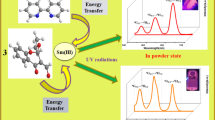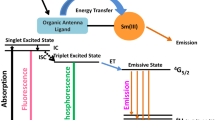Abstract
The synthesis of luminescent complexes of Sm(III) with the general formula [Sm(L)3·(X)] was done in powder form. In the formula, L is 6-methyl-4-oxo-4H-1-benzopyran-3-carboxaldehyde and X represents 2H2O (C1), 1,10-phenanthroline (C2), 2,2′-bipyridine (C3); bathophenanthroline (C4) and neocuproine (C5). The complexes were characterized by using various analytical and spectroscopic tools like elemental analysis, electrospray ionization mass spectrometry (ESI–MS+), Fourier transform infrared spectroscopy (FTIR), ultraviolet–visible (UV–Vis) spectroscopy, thermo-gravimetric analysis/ differential thermal gravimetric analysis (TGA/DTG), field emission scanning electron microscopy (FESEM), powder X-ray diffraction (XRD), and photoluminescence (PL) studies. TGA/DTG showed high thermal stability of synthesized complexes. Powder XRD depicts that the average particle size lies in the nano-range. On monitoring at the excitation wavelength of 370 nm, the complexes display characteristic luminescence peaks of Sm(III) at ~ 564, ~ 600 and ~ 647 nm assigned to 4G5/2 → 6H5/2, 4G5/2 → 6H7/2, and 4G5/2 → 6H9/2 transitions, respectively, with the most intense transition at ~ 600 (orange emission) and ~ 647 nm (bright red emission) in liquid and powder state, respectively. The investigations demonstrate that the synthesized novel complexes might be practically useful in electroluminescent devices, bio-assays, and liquid lasers due to their attractive photoluminescent properties.
Graphic abstract









Similar content being viewed by others
References
Valeur B, Santos MN. A brief history of fluorescence and phosphorescence before the emergence of quantum theory. J Chem Educ. 2011;88(6):731.
Jastrzab R, Nowak M, Skrobanska M, Tolinska A, Zabiszak M, Gabryel M, Marciniak L, Kaczmarek MT. DNA as a target for lanthanide(III) complexes influence. Coord Chem Rev. 2019;382:145.
Wu J, Liu H, Yang Y, Wang H, Yang M. A β-diketone-europium(III) complex-based time gated luminescence probe for selective visualization of peroxynitrite in living cells. Opt Mater. 2018;77:170.
Zhao S, Wang G, Poelman D, Voort PVD. Luminescent lanthanide MOFs: a unique platform for chemical sensing. Materials. 2018;11(4):572.
Dandekar MP, Itankar SB, Kondawar SB, Nandanwar DV, Koinkar P. Photoluminescent electrospun europium complex Eu(TTA)3phen embedded polymer blends nanofibres. Opt Mater. 2018;85:483.
Zheng Y, Fu L, Zhou Y, Yu J, Yu Y, Wang S, Zhang H. Electroluminescence based on a β-diketonate ternary samarium complex. J Mater Chem. 2002;12(4):919.
Nandal P, Kumar R, Khatkar A, Khatkar SP, Taxak VB. Synthesis, characterization, enhanced photoluminescence, antimicrobial and antioxidant activities of novel Sm(III) complexes containing 1-(2-hydroxy-4,6-dimethoxyphenyl)ethanone and nitrogen containing ancillary ligands. J Mater Sci Mater Electron. 2016;27(1):878.
Sosnovskikh V. Synthesis and reactions of halogen-containing chromones. Russ Chem Rev. 2003;72(6):489.
Yousuf I, Arjmand F, Tabassum S, Toupet L, Khan RA, Siddiqui MA. Mechanistic insights into a novel chromone-appended Cu(II) anticancer drug entity: in vitro binding profile with DNA/RNA substrates and cytotoxic activity against MCF-4 and HepG2 cancer cells. Dalton Trans. 2015;44(22):10330.
Shebl M, Adly OMI, Taha A, Elabd NN. Structural variety in copper(II) complexes of 3-formylchromone: synthesis, spectral, thermal, molecular modeling and biological studies. J Mol Struct. 2017;1147:438.
Adly OMI, El-Shafiy HF. New metal complexes derived from S-benzyldithiocarbazate (SBDTC) and chromone-3-carboxaldehyde: synthesis, characterization, antimicrobial, antitumor activity and DFT calculations. J Coord Chem. 2019;72(2):218.
Philip JE, Shahid M, Kurup MRP, Velayudhan MP. Metal based biologically active compounds: design, synthesis, DNA binding and antidiabetic activity of 6-methyl-3-formyl chromone derived hydrazones and their metal(II) complexes. J Photochem Photobiol B. 2017;175:178.
Tawkif HA, Ewies EF, El-Hamouly WS. Synthesis of chromones and their applications during the last ten years. IJRPC. 2014;4(4):1046.
Khan KM, Ambreen N, Mughal UR, Jalil S, Perveen S, Choudhary MI. 3-formylchromones: potential antiinflammatory agents. Eur J Med Chem. 2010;45(9):4058.
Ishar MPS, Singh G, Singh S, Sreenivasan KK, Singh G. Design, synthesis, and evaluation of novel 6-chloro-/fluorochromone derivatives as potential topoisomerase inhibitor anticancer agents. Bioorg Med Chem Lett. 2006;16(5):1366.
Pick A, Muller H, Mayer R, Haenisch B, Pajeva IK, Weigt M, Bonisch H, Muller CE, Wiese M. Structure–activity relationships of flavonoids as inhibitors of breast cancer resistance protein (BCRP). Bioorg Med Chem. 2011;19(6):2090.
Nowakowska Z. A review of anti-infective and anti-inflammatory chalcones. Eur J Med Chem. 2007;42(2):125.
Castellani CB, Carugo O, Tomba C, Gamba AI. Fluorescent lanthanide complexes. 1. Reaction between Tb3+ and 4-oxo-4H-1-benzopyran-3-carboxaldehyde in alcoholic medium. Inorg Chem. 1988;27(22):3965.
Kalanithi M, Kodimunthiri D, Rajarajan M, Tharmaraj P. Synthesis, characterization and biological activity of some new VO(IV), Co(II), Ni(II), Cu(II) and Zn(II) complexes of chromone based NNO Schiff base derived from 2-aminothiazole. Spectrochim Acta Part A. 2011;82(1):290.
Gusev AN, Shul’gin VF, Meshkova SB, Hasegawa M, Alexandrov GC, Eremenko IL, Linert W. Structural and photophysical studies on ternary Sm(III), Nd(III), Yb(III), Er(III) complexes containing pyridyltriazole ligands. Polyhedron. 2012;47(1):37.
Indrasenan P, Sarojini KR. Some lanthanide (III) nitrate complexes of N-(4′-benzoylidene-3′-methyl-1′-phenyl-pyrazol-5′-one)isonicotinylhydrazine. Indian J Chem. 1991;30A:382.
Tauc J, Grigorovici R, Vancu A. Optical properties and electronic structure of amorphous germanium. Phys Status Solidi. 1966;5(2):627.
Ren S, Jiang W, Wang Q, Li Z, Qiao Y, Che G. Synthesis, structures and properties of six lanthanide complexes based on a 2-(2-carboxyphenyl)imidazo(4,5-f)-(1,10)phenanthroline ligand. RSC Adv. 2019;9(6):3102.
Zhang D, Chen W, Wang Y. A novel samarium complex with interesting photoluminescence and semiconductive properties. Bull Chem Soc Ethiop. 2017;31(3):435.
Tillinski R, Rumpf C, Nather C, Durichen P, Jeb I, Schunk SA, Bensch W. Synthesis, crystal structures, and optical properties of new quaternary metal chacogenides of group 5: Cs2AgVS4, K2AgVSe4, Rb2AgVSe4, Rb2AgNbSe4, and Cs2AgNbSe4. Z Anorg Allg Chem. 1998;624(8):1285.
Zhou Y, He Q, Yang Y, Zhong H, He C, Sang G, Liu W, Yang C, Bai F, Li Y. Binapthyl-containing green- and red-emitting molecules for solution-processable organic light-emitting diodes. Adv Funct Mater. 2008;18(20):3299.
Hasan N, Iftikhar K. Syntheses, crystal structure and photophysical properties of [Sm(dbm)3(impy)] and [Tb(dbm)3(impy)] and their hybrid films. New J Chem. 2019;43:4391.
Ahmed Z, Dar WA, Iftikhar K. Syntheses and spectroscopic studies of volatile low symmetry lanthanide(III) complexes with monodentate 1H-indazole and fluorinated β-diketone. J Coord Chem. 2012;65(22):3932.
Lis S. Luminescence spectroscopy of lanthanide(III) ions in solution. J Alloys Compd. 2002;341(1–2):45.
Bunzli JCG. Lanthanide Probes in Life, Chemical and Earth Sciences: Theory and Practice. Amsterdam: Elsevier; 1989. p. 432.
Teotonio EES, Felinto MCFC, Brito HF, Malta OL, Trindade AC, Najjar R, Strek W. Synthesis, crystalline structure and photoluminescence investigations of the new trivalent rare earth complexes (Sm3+, Eu3+ and Tb3+) containing 2-thiophenecarbxylate as sensitizer. Inorg Chim Acta. 2004;357(2):451.
Ahmed Z, Dar WA, Iftikhar K. Synthesis and luminescence study of a highly volatile Sm(III) complex. Inorg Chim Acta. 2012;392:446.
Bala M, Kumar S, Taxak VB, Boora P, Khatkar SP. Synthesis, photoluminescent features and intramolecular transfer mechanism of europium(III) complexes with fluorinate β-diketone ligand and auxiliary ligands. J Fluor Chem. 2015;178:6.
Dexter DL. A theory of sensitized luminescence in solids. J Chem Phys. 1953;21(5):836.
Latva M, Takalo H, Mukkala V, Matachescu C, Rodriguez-Ubis JC, Kankare J. Correlation between the lowest triplet state level of the ligand and lanthanide(III) luminescence quantum yield. J Lumin. 1997;75(2):149.
Brito HF, Malta OL, Felinto MCFC, Teotonio EES, Menezes JFS, Silva CFB, Tomiyama CS, Carvalho CAA. Luminescence investigation of the Sm(III)-β-diketonates with sulfoxides, phosphine oxides and amide ligands. J Alloys Compd. 2002;344(1–2):293.
Zhang Q, Yang X, Deng R, Zhou L, Yang Y, Li Y. Synthesis and near infrared luminescent properties of a series of lanthanide complexes with POSS modified ligands. Molecules. 2019;24(7):1253.
Bala M, Kumar S, Devi R, Taxak VB, Boora P, Khatkar SP. Synthesis, NMR, photoluminescence studies and intramolecular energy transfer process of europium(III) complexes. J Fluor Chem. 2016;188:177.
Demas JN, Crosby GA. The measurement of photoluminescence quantum yields. A review. J Phys Chem. 1971;75(8):991.
Klink SI, Hebbink GA, Grave L, Alink PGBO, Veggel FCJM. Synergistic complexation of Eu3+ by a polydentate ligand and a bidentate antenna to obtain ternary complexes with high luminescence quantum yields. J Phys Chem A. 2002;106(15):3681.
Silva FRG, Malta OL, Reinhard C, Gudel H, Piguet C, Moser JE, Bunzli JG. Visible and near-infrared luminescence of lanthanide-containing dimetallic triple-stranded helicates: energy transfer mechanisms in the SmIII and YbIII molecular edifices. J Phys Chem A. 2002;106(9):1670.
Li H, Wu J, Huang W, Zhou Y, Li H, Zheng Y, Zuo J. Synthesis and photoluminescent properties of five homodinuclear lanthanide (Ln3+ = Eu3+, Sm3+, Er3+, Yb3+, Pr3+) complexes. J Photochem Photobiol A. 2009;208(2–3):110.
Castellani CB, Carugo O. Studies on fluorescent lanthanide complexes. New complexes of lanthanide(III) with coumarinic-3-carboxylic acid. Inorg Chim Acta. 1989;159(2):175.
Ain Q, Pandey SK, Pandey OP, Sengupta SK. Synthesis, structural characterization and biological studies of neodymium(III) and samarium(III) complexes with mercaptotriazole Schiff bases. Appl Organometal Chem. 2016;30:102.
Sengar M, Narula AK. Luminescence sensitization of Eu(III) complexes with aromatic Schiff base and N,N′-donor heterocyclic ligands: synthesis, luminescent properties and energy transfer. J Fluoresc. 2019;29(1):111.
Silva IGN, Morais AF, Mustafa D. Synthesis, characterization and Judd-Ofelt analysis of Sm3+-doped anhydrous Yttrium trimesate MOFs and their Y2O3:Sm3+ low temperature calcination products. J Lumin. 2019;210:335.
Roymahapatra G, Dinda J, Mishra A, Mahapatra A, Hwang W, Mandal SM. Cytotoxic potency of self-assembled Ruthenium(II)-NHC complexes with pincer type 2,6-bis(N-methylimidazolylidene/benzimidazolylidene)pyrazine ligands. J Can Res Ther. 2015;11(1):105.
Taxak VB, Kumar R, Makrandi JK, Khatkar SP. Luminescent properties of europium and terbium complexes with 2′-hydroxy-4,6′-dimethoxyacetophenone. Displays. 2010;31(3):116.
Awate R, Mishra A, Mansuri A. Synthesis and characterization of transition metal complexes with pyrimidine based ligand derivative. In: Proceedings of international conference on recent trends in physics, Indore; 2016. 012019.
Anusha A, Raj IS, Raj AG. Synthesis and characterization of bioactive transition metal complexes of Cu(II), Co(II) and Ni(II) using DFMPM and 1,4-diamino butane. Int J Res Chem Environ. 2018;8(3):9.
Lakshmanan R, Raghavan SC, Shivaprakash NC, Nair SS. Spectral characterizations and photo physical properties of one-step synthesized blue fluorescent 4′-aryl substituted 2,2′:6′,2″-terpyridine for OLEDs application. J Lumin. 2015;168:145.
Kumar V, Gohain M, Tonder JHV, Ponra S, Bezuindenhoudt BCB, Ntwaeaborwa OM, Swart HC. Synthesis of quinoline based heterocyclic compounds for blue lighting application. Opt Mater. 2015;50(Part B):275.
Bala M, Kumar S, Boora P, Taxak VB, Khatkar A, Khatkar SP. Enhanced optoelectronics properties of europium(III) complexes with β-diketone and nitrogen heterocyclic ligands. J Mater Sci Mater Electron. 2014;25(7):2850.
Yang C, Luo J, Ma J, Lu M, Liang L, Tong B. Synthesis and photoluminescent properties of four novel trinuclear europium complexes based on two tris-β-diketones ligands. Dyes Pigm. 2011;92(1):696.
Liu J, Ren N, Zhang J, Zhang C. Preparation, thermodynamic property and antimicrobial activity of some rare-earth (III) complexes with 3-bromo-5-iodobenzoic acid and 1,10-phenanthroline. Thermochim Acta. 2013;570:51.
Poonam Kumar R, Boora P, Khatkar A, Khatkar SP, Taxak VB. Synthesis, photoluminescence and biological properties of terbium(III) complexes with hydroxyketone and nitrogen containing heterocyclic ligands. Spectrochim Acta Part A. 2016;152:304.
Acknowledgements
This work was financially supported by the Senior Research Fellowship from University Grants Commission (UGC), New Delhi, India (No. 19/06/2016 (i) EU-V).
Author information
Authors and Affiliations
Corresponding author
Electronic supplementary material
Below is the link to the electronic supplementary material.
Rights and permissions
About this article
Cite this article
Chauhan, A., Langyan, R. Preparation, characterization and luminescence behavior of some samarium complexes. Rare Met. 40, 2618–2626 (2021). https://doi.org/10.1007/s12598-020-01552-9
Received:
Revised:
Accepted:
Published:
Issue Date:
DOI: https://doi.org/10.1007/s12598-020-01552-9




